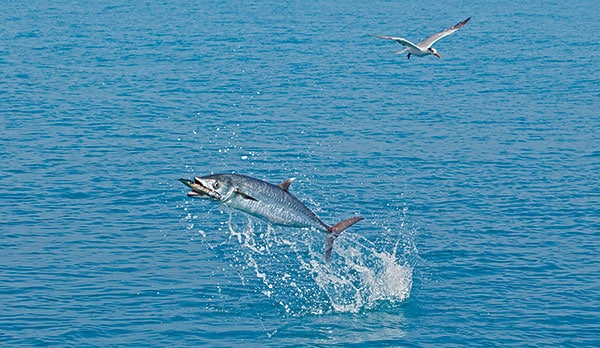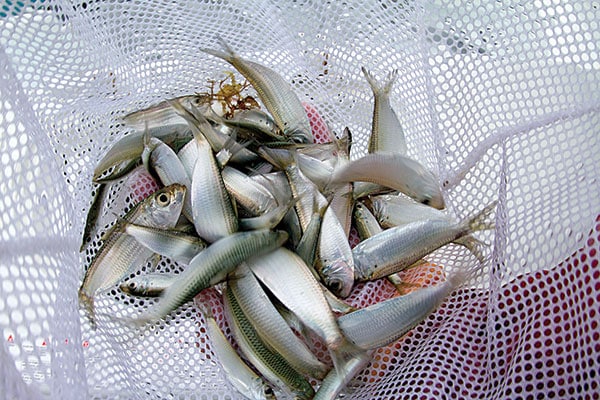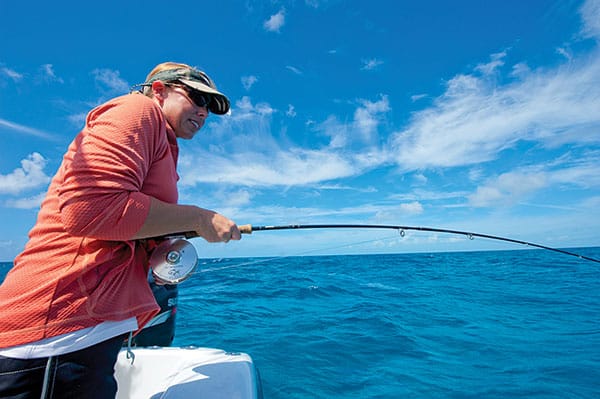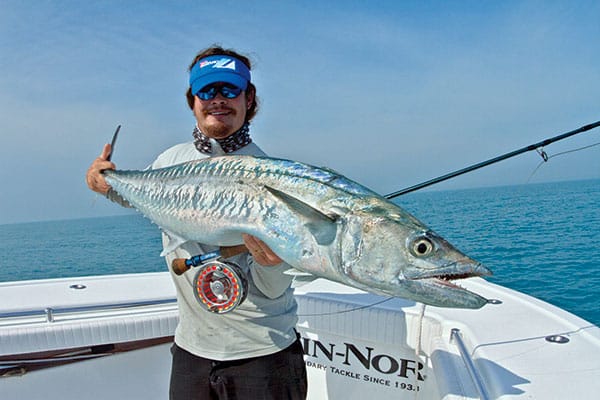
At this point in time, I’ve caught just about everything I wanted to catch on a fly rod. People ask me about favorite trips all the time, and honestly, the list constantly changes, but one that always hovers at the top is a special venture out of Key West, Florida, for king mackerel.
I arrived in Key West with the Navy in 1971 and immediately became obsessed with fishing. There was just so much to catch — I hardly knew where to start. Forty years later, I still remember a few special events from those first two years, like Jim Lopez catching two huge kingfish on fly, one of which (at 38 pounds) still holds the International Game Fish Association 12-pound-tippet record.
My first real catch was the king I landed off the Pensacola Beach pier, and shortly after arriving in Key West, I caught another 30-pounder on light spinning gear. After those two fish, I couldn’t imagine what it would be like to catch one of these speedsters on a fly rod — or even how to go about doing it. Nobody used live pilchards for chum back then, and it was pretty rare to catch a king while blind-casting over the reef. At the time, Lopez’s catches were amazing. The rumor was that he used shrimp-boat trash around Smith Shoal, but lots of people had been doing that without even seeing a king. Nobody actually went out intending to catch one on a fly, so Lopez’s records were considered pretty much untouchable.

Fast-forward a few decades, and I was still fishing Key West on a regular basis, but the style of fishing had changed. The boats were bigger and faster, the fish were farther out, and hundreds of new wrecks and reefs had been discovered with the aid of loran C and GPS. In addition, during the winter months, guides would spend the first hour or two of each charter cast-netting hundreds of live pilchards. The bait-catching process upset a lot of novice anglers until they realized how effective chumming was to concentrate all sorts of game fish right behind the boat. This opened a whole new world for fly-fishermen, and it wasn’t long before there was an influx of remarkable stories of guys catching huge kingfish on flies. Rick Gunion took a 51¼-pounder on 16-pound tippet in 1987, and Ben Bergeron set the 20-pound-tippet record with a 55-pound monster he landed in 1995 — both by using live pilchards as chum.
Chumming isn’t a matter of throwing handfuls of bait out. There’s a real science behind it. You hang a block of frozen chum over the side of the boat, and any deceased pilchards are scattered into the oil slick left by the slab. You don’t have to throw in a ton of live bait, just enough for them to form into small schools that hover right next to the boat and eventually drift back with the tide. As the live baits drift back, they should, in theory, catch the attention of any predators in the area.

First-Timer
It took me a while to set up a trip specifically targeting kings on fly with Capt. R.T. Trosset. The kings usually appear in mid-December and hang around until early March, but they need to be concentrated for the fly gig to work. At times they would appear early in the season in the Atlantic at Western Dry Rocks, at the end of the bar or off Tail End, and when conditions were right, they would migrate into the Gulf northwest of the Marquesas. Wind, cold fronts, water temperatures, bait supplies and tides all play a role, but you still need to find a stationary school of feeding kingfish, which isn’t all that easy. Trosset basically put me on standby for several years, assuring me that when all the pieces fell together, he’d give me a call and we’d give it a try.
Our first official trip for kings was a great success. We found them in the Gulf in only 50 feet of water, and I quickly learned that fast-sinking line worked best, with a clear intermediate coming in second. A 10-, 11- or 12-weight rod worked fine when matched with a reel with a fast retrieve and lots of backing. A wire leader was a must, and the fish seemed to prefer big, bushy synthetic baitfish patterns that were about twice the size of the pilchards we were using for chum. The idea was to cast as far as I could, let the fly sink for a serious amount of time and then strip like mad. Sometimes the kings were visible behind the boat, but the ones I saw were never the ones I hooked. The biggest one I caught that first trip was probably 20 pounds, and I had a ball. The strike stops your heart, and the first run leaves you wondering if it will ever end. If there’s a downside to this fishery, it’s that you lose about two-thirds of the fish you hook. I’m not sure why — they just fall off the hook at some point during the fight. That first trip was my undoing, and I could hardly wait to get back. Several years of frustration from bad conditions and trips on which we never found fish didn’t stop me from trying. Every so often we would get into them and hook a few, but I never did get that 30-pounder I was lusting after. Finally, last year, the stars aligned.

Off to the Marquesas
The kings appeared sporadically last December and January in the Atlantic, but the Gulf remained quiet. We found a few off Western Dry Rocks one day, but a pod of dolphin moved in and ate everything we hooked. In late January, the kings schooled up once again off the Marquesas and then moved into the Gulf and disappeared. They were here one day and gone the next. Rufus Wakeman and I were scheduled to fish with Trosset the first week in February, and we all agreed that if there were a snowball’s chance of finding kingfish, we would try.
Wakeman is one of my favorite fishing companions — his good luck usually cancels out my bad luck. We met Trosset and his son, Chris, at their slip in Hurricane Hole Marina at 7 a.m. Conditions were perfect. Light winds and pilchards aplenty gave us a sense of hope, and before long, our captain pointed the bow west toward the Marquesas and hit the throttle. The plan was to check a few wrecks in the Quicksands for cobia and then shift northwest into the Gulf. Trosset knew of several spots that sometimes held schools of kings, but no one had fished them recently, so we were taking a chance. The shallow wrecks were pretty much dead, and after checking three without seeing a cobia, we ran some 15 miles into the Gulf. The seas were flat calm, which in February is as rare as a wooden nickel, and our first stop was at a patch reef in 60 feet of water. The tide was almost high, so we strategically anchored up so the chum would wash over the reef. Chris put over a block of frozen chum while R.T. dished out a few freebie pilchards. An hour later, all we had behind the boat were sharks, jacks and a swarm of pelicans. We caught our fill of jacks in short order, but there wasn’t a king to be found.
Our next spot was about a mile away, and we wasted another 45 minutes feeding sharks before deciding to pick up and move once again. Conditions were absolutely wonderful, but we couldn’t rent a kingfish. R.T. quietly told me that he had one more spot worth checking, but if it failed, we’d have to go almost to the Dry Tortugas. We ran a few miles before anchoring up for the third time. By then it was noon, and the tide was just starting to fall. I like an outgoing tide in the Gulf, and we crossed our fingers and began chumming yet again. After 20 minutes, our only consolation was that there weren’t any jacks or sharks around — the bad news was that we still hadn’t seen a kingfish. I could tell R.T. was in the initial stage of panic when the first flash appeared.

Kings Welcome
The first sign of kings is usually an explosion way behind the boat. R.T. always puts one of the larger live baits out on a wire leader, and if nothing hits it, there isn’t much use throwing a fly into the mix. We’d probably been at this spot a half-hour before the live-bait rod started to sing. Finally we were in the presence of kings.
Wakeman took up position in one corner of the stern, and I parked in the other. I started out with a 10-weight Loop rod-and-reel combo loaded with a fast-sinking striper line. We couldn’t see anything in the water, but the kings were whacking the pilchards way behind the boat, and hopefully there were some closer in. I had drawn the left side, so I had to backcast to the fish. On my third cast, something nailed the fly and took off while I tried desperately to clear the line that was tangled around my feet. I managed to get most of it, but the last loop caught on the corner of the bolster and wouldn’t come free. I struggled with it for a moment or two before the king took off again, snapping the tippet. I was muttering to myself as R.T. came over. “It was a king, and a big one for sure!” he said. We were in business.
Over the next few hours, we participated in some of the most amazing fly-fishing you could ever experience. Gradually the kings moved in closer and closer until we could see them cruising below and behind us. The third fish I hooked raced out a hundred yards and circled the boat twice before I could work it into gaff range. When the fish was put on the scale, I was thrilled to see it weighed 35½ pounds. Wakeman eventually caught one that was 36 pounds, but I didn’t care. I’d finally caught a monster king mackerel on fly after 40 years of wishing and hoping. This was Wakeman’s first experience with kings on fly, and he understood he’d hit the mother lode. All in all, we landed over 20 kings on fly that day — all over 20 pounds. In three hours’ time, we un-doubtedly lost twice that many. What made this trip extra special was that we actually teased the kings into a frenzy by throwing a hookless plug into the chum slick. One king would skyrocket on the lure and drop it in midair, then another would hit it after it landed on the water. When the plug came into range, a fly cast next to it drew a crushing strike instantly. R.T. and I spent as much time playing with the fish as we did fishing for them.
In Search of a 50-Pounder
As we ran back to Key West that afternoon, we had little doubt what our plans were for the following day, but it was not to be. The next morning brought 25-knot winds, and we couldn’t even think about running 60 miles into the Gulf. A few weeks later, I was back with R.T. on another slick-calm day that had kings written all over it. We ran right back to the same patch reef but didn’t find anything. We hopped around to several hot spots in the area but never connected. Same tides, same conditions — no kings. I think it’s the unpredictably of this fishery that makes it so exciting. By the end of February, it’s pretty much over, but we’re already planning our trips for next year. I know that repeating my trip with Wakeman is a long shot, but there’s always a chance, and that chance is all it takes for me to try each year. Who knows? Maybe one of these days I’ll find myself buttoned up to a 50-pounder. When you are fishing out of Key West, anything is possible.









